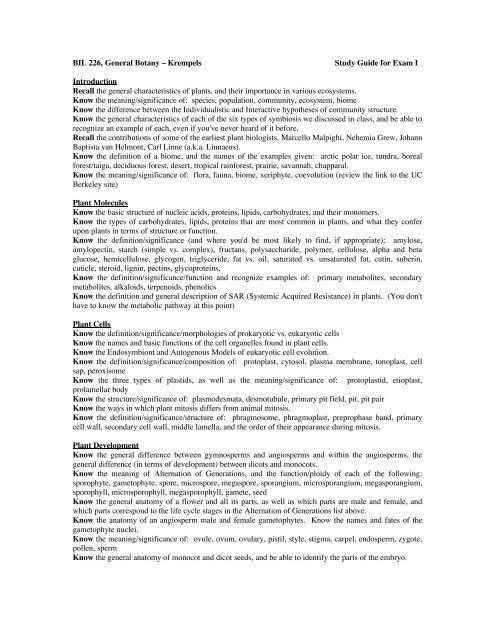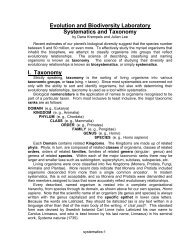BIL 226, General Botany – Krempels Study Guide for Exam I ...
BIL 226, General Botany – Krempels Study Guide for Exam I ...
BIL 226, General Botany – Krempels Study Guide for Exam I ...
You also want an ePaper? Increase the reach of your titles
YUMPU automatically turns print PDFs into web optimized ePapers that Google loves.
<strong>BIL</strong> <strong>226</strong>, <strong>General</strong> <strong>Botany</strong> – <strong>Krempels</strong><br />
<strong>Study</strong> <strong>Guide</strong> <strong>for</strong> <strong>Exam</strong> I<br />
Introduction<br />
Recall the general characteristics of plants, and their importance in various ecosystems.<br />
Know the meaning/significance of: species, population, community, ecosystem, biome<br />
Know the difference between the Individualistic and Interactive hypotheses of community structure.<br />
Know the general characteristics of each of the six types of symbiosis we discussed in class, and be able to<br />
recognize an example of each, even if you've never heard of it be<strong>for</strong>e.<br />
Recall the contributions of some of the earliest plant biologists, Marcello Malpighi, Nehemia Grew, Johann<br />
Baptista van Helmont, Carl Linne (a.k.a. Linnaeus).<br />
Know the definition of a biome, and the names of the examples given: arctic polar ice, tundra, boreal<br />
<strong>for</strong>est/taiga, deciduous <strong>for</strong>est, desert, tropical rain<strong>for</strong>est, prairie, savannah, chapparal.<br />
Know the meaning/significance of: flora, fauna, biome, xeriphyte, coevolution (review the link to the UC<br />
Berkeley site)<br />
Plant Molecules<br />
Know the basic structure of nucleic acids, proteins, lipids, carbohydrates, and their monomers.<br />
Know the types of carbohydrates, lipids, proteins that are most common in plants, and what they confer<br />
upon plants in terms of structure or function.<br />
Know the definition/significance (and where you'd be most likely to find, if appropriate): amylose,<br />
amylopectin, starch (simple vs. complex), fructans, polysaccharide, polymer, cellulose, alpha and beta<br />
glucose, hemicellulose, glycogen, triglyceride, fat vs. oil, saturated vs. unsaturated fat, cutin, suberin,<br />
cuticle, steroid, lignin, pectins, glycoproteins,<br />
Know the definition/significance/function and recognize examples of: primary metabolites, secondary<br />
metabolites, alkaloids, terpenoids, phenolics<br />
Know the definition and general description of SAR (Systemic Acquired Resistance) in plants. (You don't<br />
have to know the metabolic pathway at this point)<br />
Plant Cells<br />
Know the definition/significance/morphologies of prokaryotic vs. eukaryotic cells<br />
Know the names and basic functions of the cell organelles found in plant cells.<br />
Know the Endosymbiont and Autogenous Models of eukaryotic cell evolution.<br />
Know the definition/significance/composition of: protoplast, cytosol, plasma membrane, tonoplast, cell<br />
sap, peroxisome<br />
Know the three types of plastids, as well as the meaning/significance of: protoplastid, etioplast,<br />
prolamellar body<br />
Know the structure/significance of: plasmodesmata, desmotubule, primary pit field, pit, pit pair<br />
Know the ways in which plant mitosis differs from animal mitosis.<br />
Know the definition/significance/structure of: phragmosome, phragmoplast, preprophase band, primary<br />
cell wall, secondary cell wall, middle lamella, and the order of their appearance during mitosis.<br />
Plant Development<br />
Know the general difference between gymnosperms and angiosperms and within the angiosperms, the<br />
general difference (in terms of development) between dicots and monocots.<br />
Know the meaning of Alternation of Generations, and the function/ploidy of each of the following:<br />
sporophyte, gametophyte, spore, microspore, megaspore, sporangium, microsporangium, megasporangium,<br />
sporophyll, microsporophyll, megasporophyll, gamete, seed<br />
Know the general anatomy of a flower and all its parts, as well as which parts are male and female, and<br />
which parts correspond to the life cycle stages in the Alternation of Generations list above.<br />
Know the anatomy of an angiosperm male and female gametophytes. Know the names and fates of the<br />
gametophyte nuclei.<br />
Know the meaning/significance of: ovule, ovum, ovulary, pistil, style, stigma, carpel, endosperm, zygote,<br />
pollen, sperm<br />
Know the general anatomy of monocot and dicot seeds, and be able to identify the parts of the embryo.
Know the meaning/significance of chalazal pole, micropylar pole, apical cell, basal cell, embryo, suspensor<br />
(which comes from which, and at which pole), the various stages of the embryo, from globule to mature<br />
embryo.<br />
Know the three primary meristems, their relative positions in the embryo, and the tissues to which each<br />
gives rise.<br />
Know the ploidy of the various parts of the angiosperm seed: seed coat, endosperm, embryo, etc.<br />
Review different modes of seed dispersal. Understand the concept of after-ripening, and what<br />
environmental factors can be involved in this process.<br />
Know the difference between epigeous and hypogeous growth at germination.<br />
Plant Tissues<br />
Know the factors that allowed plants to truly colonize land and become more independent of water as a<br />
medium in which to live.<br />
Know the three organs of a plant.<br />
Know the meaning/significance/morphology of: meristem, ground tissue, vascular tissue, dermal tissue,<br />
simple vs. complex tissue, parenchyma, chlorenchyma, collenchyma, sclerenchyma, sclerid, fiber, sieve<br />
cell, sieve tube element, companion cell, albuminous cell (see text), tracheid, vessel element, xylem,<br />
phloem, guard cells, trichomes, glabrous, pubescent, hirsute.<br />
Know the meaning/significance/morphology of: cells that are totipotent, pluripotent, and multipotent.<br />
Know the general anatomy of a plant: root, stem, leaf, node, internode, leaf axil, apical bud, axillary bud,<br />
leaf scar, vascular and cork cambia, stele (and relative locations of xylem and phloem therein), periderm<br />
Know the meaning/significance of: primary growth, secondary growth, determinate vs. indeterminate<br />
growth, annual vs. perennial life history<br />
The Leaf<br />
Know the structure and significance of the following leaf parts and leaf-related structures: petiole, base,<br />
midrib, veins, margins, blade, apex, axil, axillary bud, stipule<br />
Know the basic <strong>for</strong>ms of phyllotaxy, and be able to recognize illustrations of them, including: helical,<br />
distichous (alternate), opposite, opposite and dicussate, and whorled leaf arrangements<br />
Recognize the most common leaf shapes and the names of those shapes (in both simple and compound<br />
<strong>for</strong>m, as applicable): pinnate, palmate, orbicular, ovate, obovate, cordate, reni<strong>for</strong>m, acuminate, peltate,<br />
lobed<br />
Recognize the following vein morphologies: palmate, pinnate, reticulate, parallel<br />
Know the layers and locations of the various structures and internal layers of the leaf, including: cuticle,<br />
epidermis, pallisade parenchyma, spongy parenchyma, stomates, guard cells, trichomes, leaf gap adn leaf<br />
trace (on the stem), and the vascular tissue locations in the veins.<br />
Know the meaning/significance of hydrophyte, mesophyte, xerophyte<br />
Know the meaning/significance/function of minor veins, major veins, bundle sheath, bundle sheath<br />
extensions<br />
Know the general course of new leaf <strong>for</strong>mation from the apical meristem, and the morphology, location,<br />
and function of: founder cells, leaf buttress, leaf primordia<br />
Recognize the various types of leaf specializations and their functions.

















